Bibliometric Analysis of Cross-Sectional Studies on Early Childhood Caries
Abstract
1. Introduction
2. Materials and Methods
2.1. Data Source
2.2. Search Strategy
2.3. Data Analysis
3. Results
3.1. Publications and Citations Data
3.2. Co-Authorship Analysis Regarding Number of Articles
3.3. Co-Authorship Analysis Regarding Countries and Organizations
3.4. Citation Analysis and Co-Citation Network
3.5. Keywords Analysis
4. Discussion
5. Conclusions
Funding
Institutional Review Board Statement
Informed Consent Statement
Data Availability Statement
Acknowledgments
Conflicts of Interest
Abbreviations
| ECC | Early childhood caries |
| OHQoL | Overall health-related quality of life |
| ECOHIS | Early Childhood Oral Health Impact Scale |
| S-ECC | Severe early childhood caries |
References
- Sharna, N.; Ramakrishnan, M.; Samuel, V.; Ravikumar, D.; Cheenglembi, K.; Anil, S. Association between Early Childhood Caries and Quality of Life: Early Childhood Oral Health Impact Scale and Pufa Index. Dent. J. 2019, 7, 95. [Google Scholar] [CrossRef] [PubMed]
- Duangthip, D.; Chen, K.J.; Gao, S.S.; Lo, E.C.M.; Chu, C.H. Early childhood caries among 3- to 5-year-old children in Hong Kong. Int. Dent. J. 2019, 69, 230–236. [Google Scholar] [CrossRef] [PubMed]
- Finlayson, T.L.; Cabudol, M.; Liu, J.X.; Garza, J.R.; Gansky, S.A.; Ramos-Gomez, F. A qualitative study of the multi-level influences on oral hygiene practices for young children in an Early Head Start program. BMC Oral Health 2019, 19, 166. [Google Scholar] [CrossRef]
- Anil, S.; Anand, P.S. Early Childhood Caries: Prevalence, Risk Factors, and Prevention. Front. Pediatr. 2017, 5, 157. [Google Scholar] [CrossRef] [PubMed]
- Nassar, A.A.; Fatani, B.A.; Almobarak, O.T.; Alotaibi, S.I.; Alhazmi, R.A.; Marghalani, A.A. Knowledge, Attitude, and Behavior of Parents Regarding Early Childhood Caries Prevention of Preschool Children in Western Region of Saudi Arabia: A Cross-Sectional Study. Dent. J. 2022, 10, 218. [Google Scholar] [CrossRef]
- Alshehri, A. Social and Behavioral Determinants of Early Childhood Caries in the Aseer Region of Saudi Arabia. Mathews J. Dent. 2016, 1, 1–6. [Google Scholar] [CrossRef]
- Lembacher, S.; Hofer, V.; Bekes, K. The Impact of Dental Pain on the Oral Health-Related Quality of Life (OHRQoL) of Preschool Children in Austria. J. Clin. Med. 2023, 12, 5906. [Google Scholar] [CrossRef]
- Watt, R.G.; Daly, B.; Allison, P.; Macpherson, L.M.D.; Venturelli, R.; Listl, S.; Weyant, R.J.; Mathur, M.R.; Guarnizo-Herreño, C.C.; Celeste, R.K.; et al. Ending the neglect of global oral health: Time for radical action. Lancet 2019, 394, 261–272. [Google Scholar] [CrossRef]
- Meyer, F.; Enax, J. Early Childhood Caries: Epidemiology, Aetiology, and Prevention. Int. J. Dent. 2018, 2018, 1415873. [Google Scholar] [CrossRef]
- Abdat, M.; Ramayana, I. Relationship between mother’s knowledge and behaviour with oral health status of early childhood. Padjajaran J. Dent. 2020, 32, 166–173. [Google Scholar] [CrossRef]
- Acharya, P.; Jawdekar, A.; Katre, A. Severe Early Childhood Caries (S-ECC) and General Health Status (GHS) in One to Two Year-Old Children Related to Bottle-Feeding, in Urban Indian Population- A Cross-Sectional Study. EC Paediatr. 2021, 10, 52–66. [Google Scholar] [CrossRef]
- Fan, C.C.; Wang, W.H.; Xu, T.; Zheng, S.G. Risk factors of early childhood caries (ECC) among children in Beijing—A prospective cohort study. BMC Oral Health 2019, 19, 34. [Google Scholar] [CrossRef] [PubMed]
- Samuel, S.R.; Acharya, S.; Rao, J.C. School Interventions-based Prevention of Early-Childhood Caries among 3-5-year-old children from very low socioeconomic status: Two-year randomized trial. J. Public Health Dent. 2020, 80, 51–60. [Google Scholar] [CrossRef]
- Ji, M.; Fu, D.; Liao, G.; Zou, L. A Bibliometric Analysis of Studies on Root Caries. Caries Res. 2023, 57, 32–42. [Google Scholar] [CrossRef] [PubMed]
- Torres-Loyola, A.; Rojas-Arana, C.; Munive-Degregori, A.; Guerrero, M.E.; Mauricio, F.; Pacheco-Mendoza, J.; Mayta-Tovalino, F. Bibliometric Analysis of the Current Landscape of Global Scientific Production on the Development of Vaccines against Dental Caries. Int. J. Dent. 2022, 2022, 7678891. [Google Scholar] [CrossRef]
- Alam, B.F.; Najmi, M.A.; Qasim, S.B.; Almulhim, K.S.; Ali, S. A bibliometric analysis of minimally invasive dentistry: A review of the literature from 1994 to 2021. J. Prosthet. Dent. 2023, 130, 179–186. [Google Scholar] [CrossRef]
- Pinella Vega, M.; Romero-Gamboa, J.; Gallego-Ramírez, J.; Millones Gómez, P.; Valencia-Arias, A. Risk factors associated with early childhood caries: A bibliometric analysis. J. Pharm. Pharmacogn. Res. 2024, 12, 683–700. [Google Scholar] [CrossRef]
- Patil, S.S.; Sarode, S.C.; Sarode, G.S.; Gadbail, A.R.; Gondivkar, S.; Kontham, U.R.; Alqahtani, K.M. A bibliometric analysis of the 100 most cited articles on early childhood caries. Int. J. Paediatr. Dent. 2020, 30, 527–535. [Google Scholar] [CrossRef]
- Melo, M.; Sanz, J.L.; Forner, L.; Rodríguez-Lozano, F.J.; Guerrero-Gironés, J. Current Status and Trends in Research on Caries Diagnosis: A Bibliometric Analysis. Int. J. Environ. Res. Public Health 2022, 19, 5011. [Google Scholar] [CrossRef]
- Huang, C.-H.; Liu, J.; Ho, M.; Chou, T.-C. Towards More Convergent Main Paths: A Relevance-based Approach. J. Inf. 2022, 16, 101317. [Google Scholar] [CrossRef]
- Qasim, S.S.B.; Ali, D.; Khan, A.S.; Rehman, S.U.; Iqbal, A.; Baskaradoss, J.K. Evidence-Based Bibliometric Analysis of Research on Silver Diamine Fluoride Use in Dentistry. Biomed. Res. Int. 2021, 2021, 9917408. [Google Scholar] [CrossRef]
- Rocha, A.O.; Santos, P.S.; Machado, B.A.; Bolan, M.; Cardoso, M.; Martins-Júnior, P.A.; Santana, C.M. The Top 100 Most-Cited Papers in Erosive Tooth Wear: A Bibliometric Analysis. Caries Res. 2022, 56, 29–35. [Google Scholar] [CrossRef]
- Arshad, A.I.; Ahmad, P.; Dummer, P.M.H.; Alam, M.K.; Asif, J.A.; Mahmood, Z.; Rahman, N.A.; Mamat, N. Citation Classics on Dental Caries: A Systematic Review. Eur. J. Dent. 2020, 14, 128–143. [Google Scholar] [CrossRef]
- Mahmoud, N.; Kowash, M.; Hussein, I.; Hassan, A.; Al Halabi, M. Oral Health Knowledge, Attitude, and Practices of Sharjah Mothers of Preschool Children, United Arab Emirates. J. Int. Soc. Prev. Community Dent. 2017, 7, 308–314. [Google Scholar] [CrossRef] [PubMed]
- Vollú, A.L.; da Costa, M.; Maia, L.C.; Fonseca-Gonçalves, A. Evaluation of Oral Health-Related Quality of Life to Assess Dental Treatment in Preschool Children with Early Childhood Caries: A Preliminary Study. J. Clin. Pediatr. Dent. 2018, 42, 37–44. [Google Scholar] [CrossRef]
- Lim, W.M.; Kumar, S. Advancing knowledge through literature reviews: “what”, “why”, and “how to contribute”. Serv. Ind. J. 2022, 42, 481–513. [Google Scholar] [CrossRef]
- Goebel, M.C.; Rocha, A.O.; Santos, P.S.; Bolan, M.; Martins-Júnior, P.A.; Santana, C.M.; Cardoso, M. A Bibliometric Analysis of the Top 100 Most-Cited Papers Concerning Dental Fluorosis. Caries. Res. 2023, 57, 509–515. [Google Scholar] [CrossRef] [PubMed]
- Ohta, L.; O’Brien, B.; Knight, H.; Patel, J.; Anthonappa, R.P. Publication Trends in Pediatric Dentistry Journal: A 20-year Bibliometric Analysis (1999–2018). Pediatr. Dent. 2020, 42, 354–358. [Google Scholar] [PubMed]
- Bratu, D.C.; Nikolajevic-Stoican, N.; Popa, G.; Pop, S.I.; Dragoș, B.; Luca, M.M. A Bibliometric Analysis (2010–2020) of the Dental Scientific Literature on Chemo-Mechanical Methods of Caries Removal Using Carisolv and BRIX3000. Medicina 2022, 58, 788. [Google Scholar] [CrossRef]
- Guleria, D.; Bains, G. Bibliometric analysis of ecopreneurship using VOSviewer and RStudio Bibliometrix, 1989–2019. Library Hi Tech 2021, 39, 1001–1024. [Google Scholar] [CrossRef]
- McAllister, J.T.; Lennertz, L.; Atencio Mojica, Z. Mapping A Discipline: A Guide to Using VOSviewer for Bibliometric and Visual Analysis. Sci. Technol. Libr. 2022, 41, 319–348. [Google Scholar] [CrossRef]
- Ullah, M.; Shahid, A.; Din, I.; Roman, M.; Assam, M.; Fayaz, M.; Ghadi, Y.; Aljuaid, H. Analyzing Interdisciplinary Research Using Co-Authorship Networks. Complexity 2022, 2022, 2524491. [Google Scholar] [CrossRef]
- Fagan, J.; Eddens, K.S.; Dolly, J.; Vanderford, N.L.; Weiss, H.; Levens, J.S. Assessing Research Collaboration through Co-authorship Network Analysis. J. Res. Adm. 2018, 49, 76–99. [Google Scholar] [PubMed]
- McManus, C.; Neves, A.A.B.; Diniz Filho, J.A.; Pimentel, F.; Pimentel, D. Funding as a determinant of Citation Impact in Scientific Papers in different countries. An. Acad. Bras. Cienc. 2023, 95, e20220515. [Google Scholar] [CrossRef]
- Naidu, R.; Nunn, J.; Donnelly-Swift, E. Oral health-related quality of life and early childhood caries among preschool children in Trinidad. BMC Oral Health 2016, 16, 128. [Google Scholar] [CrossRef] [PubMed]
- Ahmad, P.; Alam, M.K.; Jakubovics, N.S.; Schwendicke, F.; Asif, J.A. 100 Years of the Journal of Dental Research: A Bibliometric Analysis. J. Dent. Res. 2019, 98, 1425–1436. [Google Scholar] [CrossRef] [PubMed]
- Sabharwal, A.; Stellrecht, E.; Scannapieco, F.A. Associations between dental caries and systemic diseases: A scoping review. BMC Oral Health 2021, 21, 472. [Google Scholar] [CrossRef]
- Alamri, H. Oral Care for Children with Special Healthcare Needs in Dentistry: A Literature Review. J. Clin. Med. 2022, 11, 5557. [Google Scholar] [CrossRef]
- Willinsky, J. Scholarly Associations and the Economic Viability of Open Access Publishing. Health Sci. OJS Theme Demo 2005, 4, 1–25. [Google Scholar]
- Singh, V.; Singh, P.; Karmakar, M.; Leta, J.; Mayr, P. The journal coverage of Web of Science, Scopus and Dimensions: A comparative analysis. Scientometrics 2021, 126, 5113–5142. [Google Scholar] [CrossRef]
- Chen, C.; Song, M. Visualizing a field of research: A methodology of systematic scientometric reviews. PLoS ONE 2019, 14, e0223994. [Google Scholar] [CrossRef] [PubMed]
- Edelstein, B.L. Pediatric Dental-Focused Interprofessional Interventions: Rethinking Early Childhood Oral Health Management. Dent. Clin. N. Am. 2017, 61, 589–606. [Google Scholar] [CrossRef] [PubMed]
- Aksnes, D.W.; Langfeldt, L.; Wouters, P. Citations, Citation Indicators, and Research Quality: An Overview of Basic Concepts and Theories. SAGE Open 2019, 9, 2158244019829575. [Google Scholar] [CrossRef]
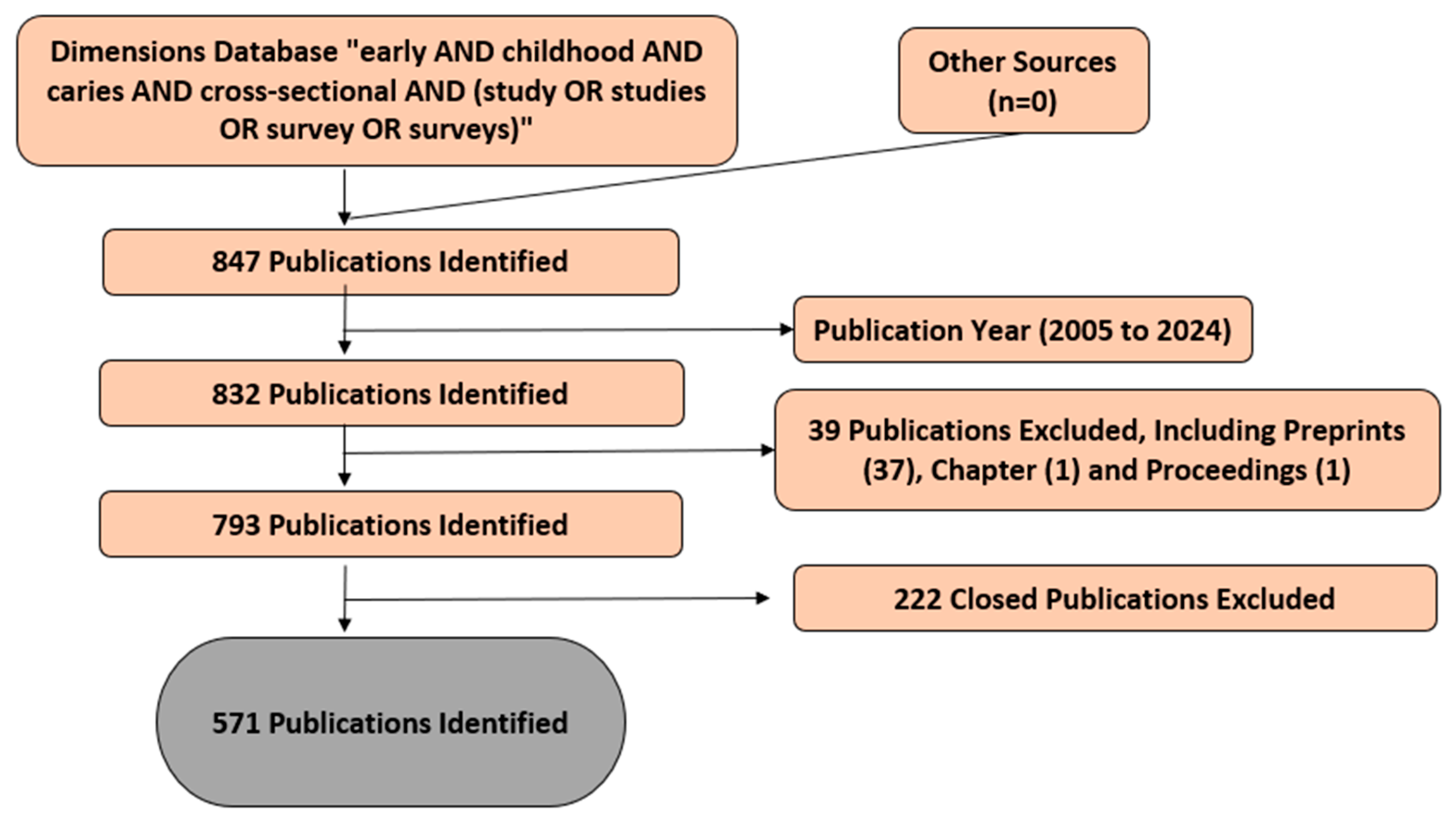
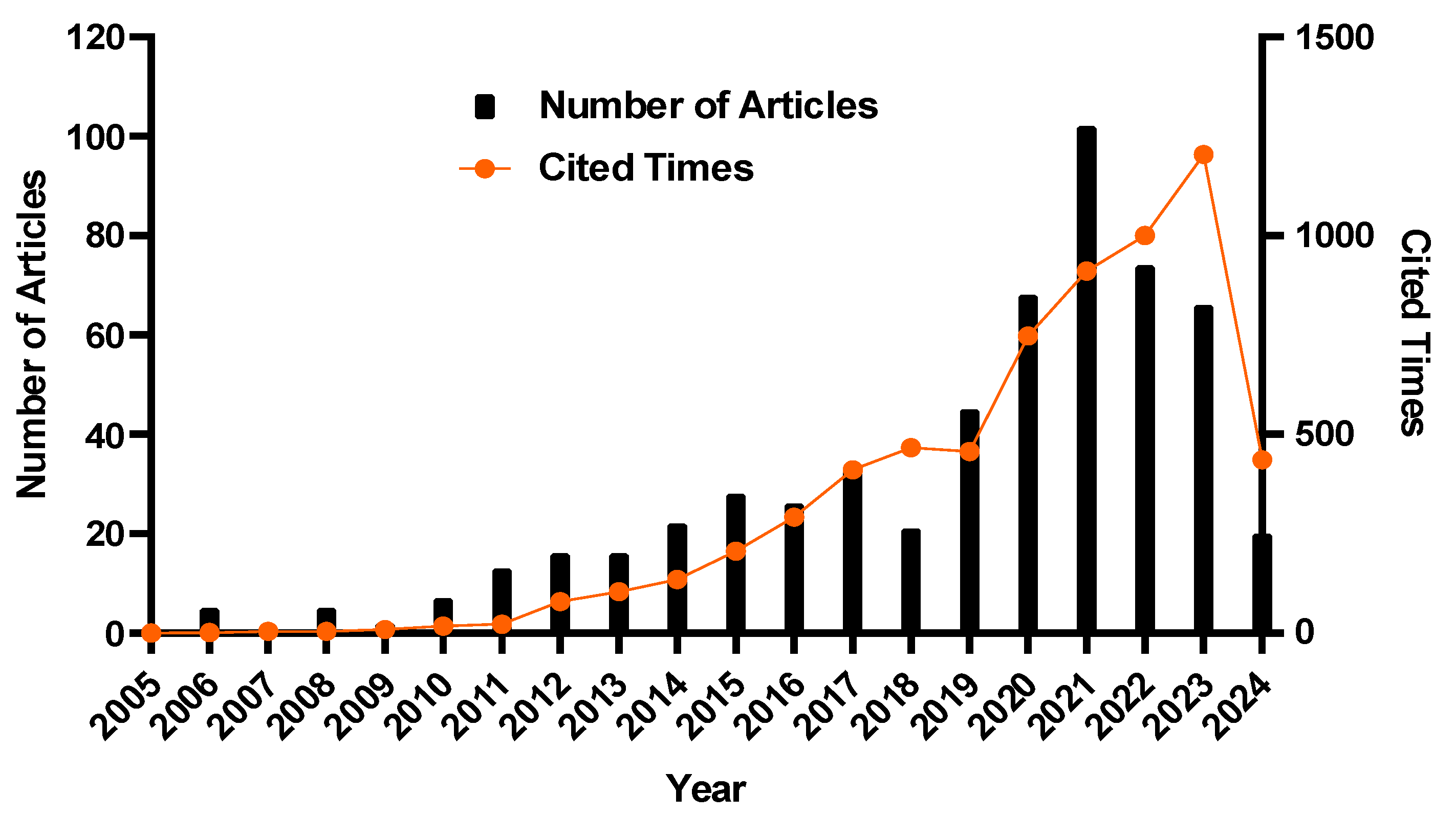


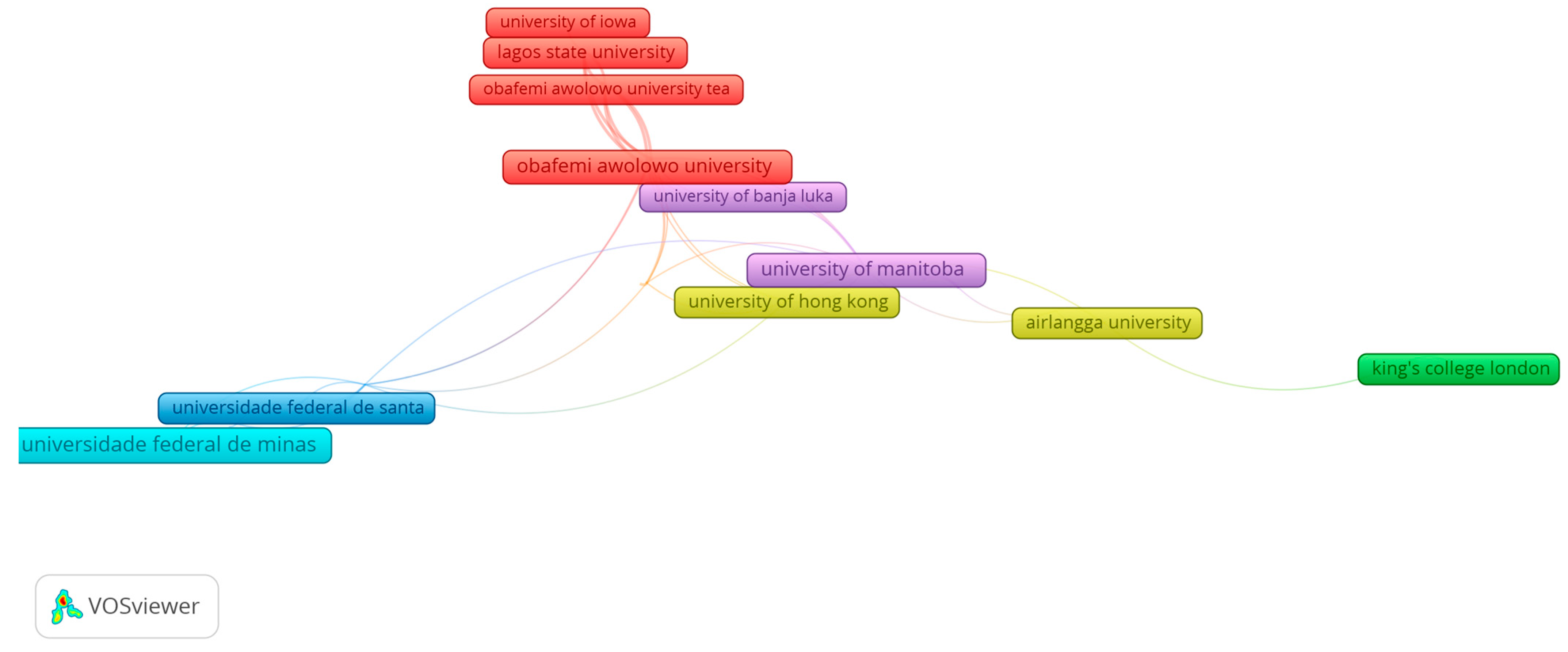
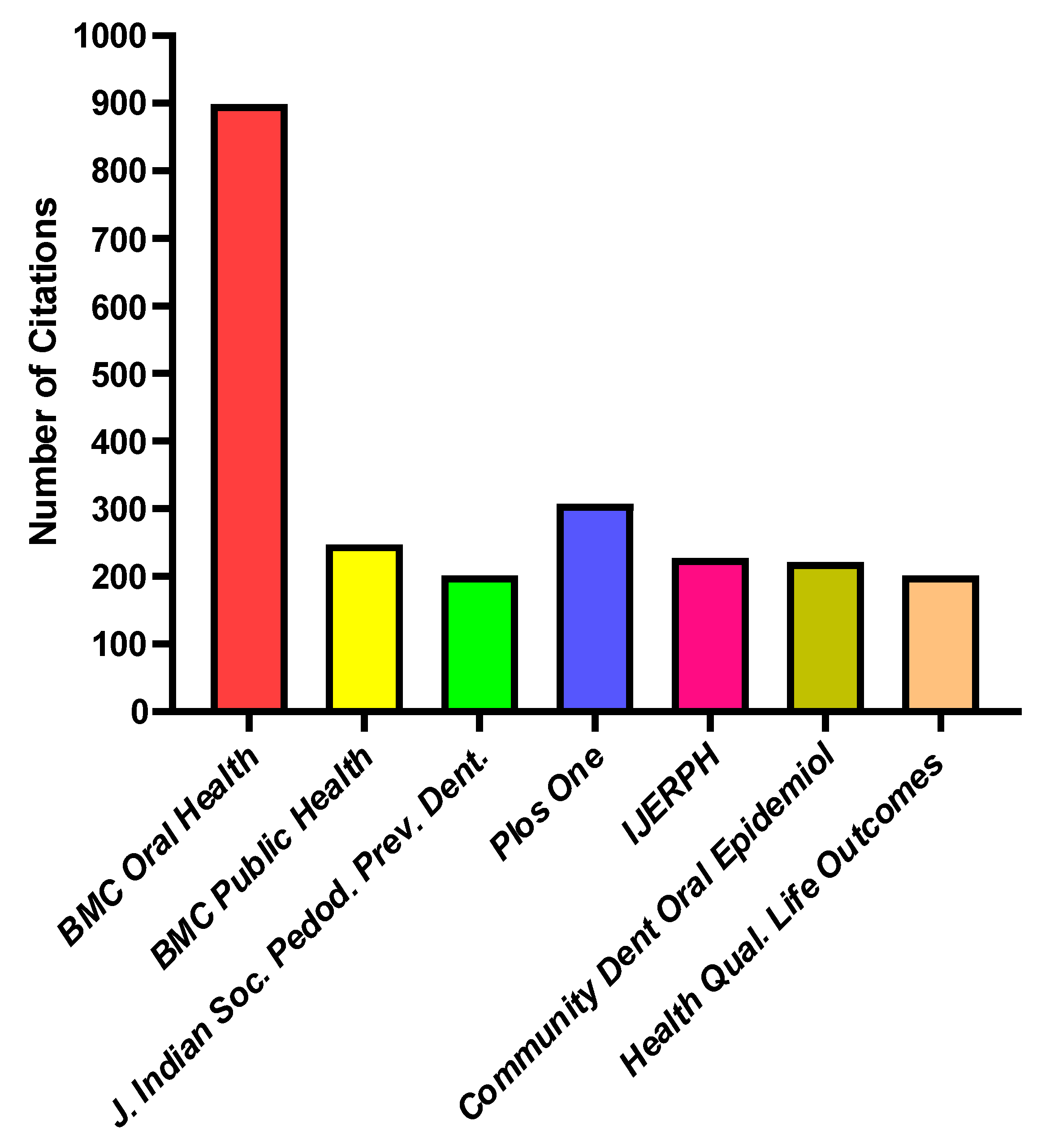

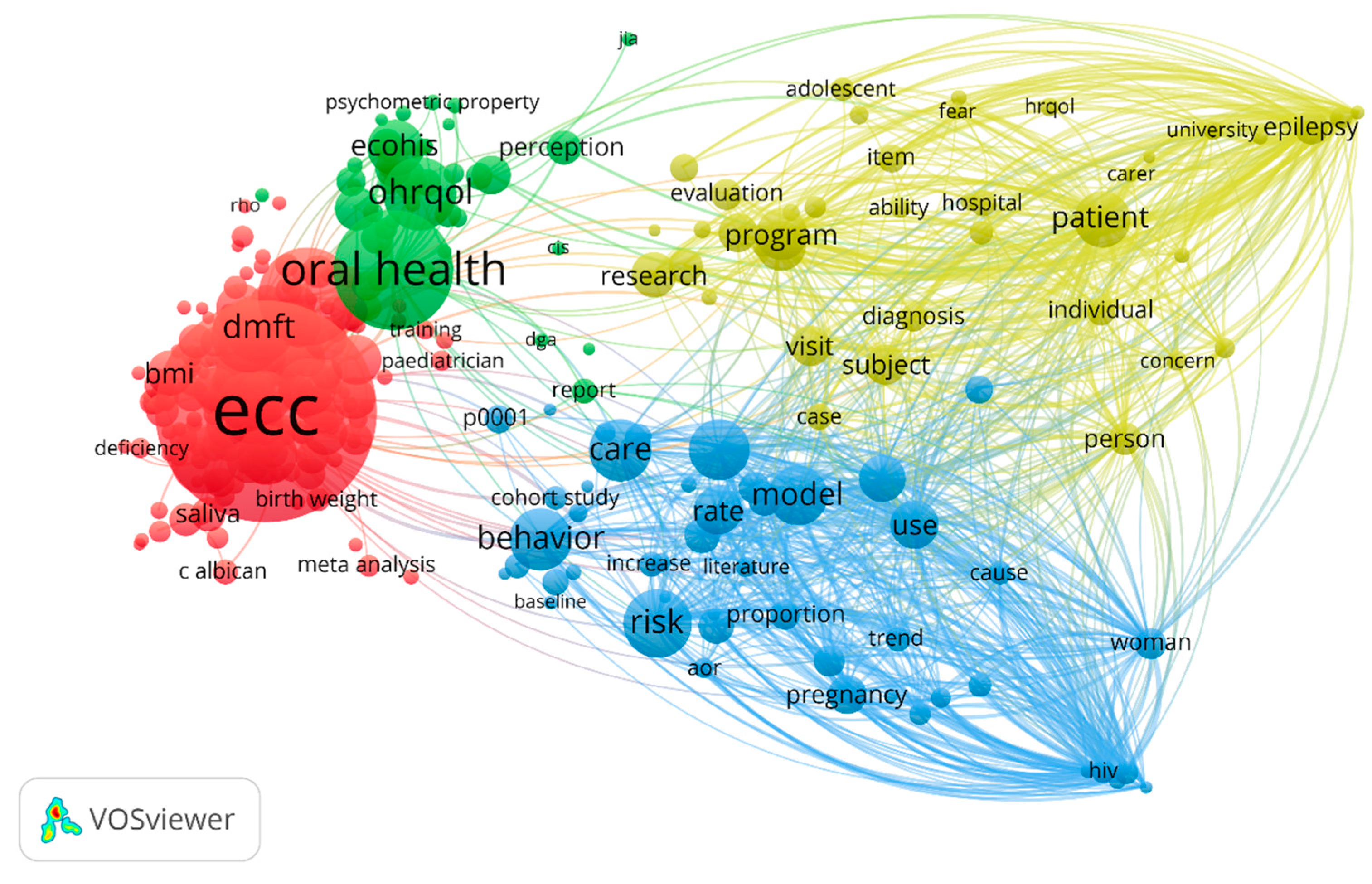
| Groups | Documents | Percentage (%) | Citations | ACI | TLS |
|---|---|---|---|---|---|
| Group 1 (Red) | |||||
| Paiva, Saul Martins | 10 | 1.8 | 294 | 29.4 | 19 |
| Gomes, Monalisa Cesarino | 6 | 1.1 | 280 | 46.7 | 18 |
| Granville-Garcia, Ana Flavia | 6 | 1.1 | 280 | 46.7 | 18 |
| Martins, Carolina Castro | 6 | 1.1 | 280 | 46.7 | 18 |
| Group 2 (Green) | |||||
| Feldens, Carlos Alberto | 5 | 0.9 | 197 | 39.4 | 7 |
| Ardenghi, Thiago Machado | 5 | 0.9 | 22 | 4.4 | 4 |
| Knorst, Jessica Klockner | 5 | 0.9 | 20 | 4 | 4 |
| Schroth, Robert j | 5 | 0.9 | 199 | 39.8 | 4 |
| Group 3 (Blue) | |||||
| Folayan, Morenike Oluwatoyin | 9 | 1.6 | 108 | 12 | 14 |
| El Tantawi, Maha | 5 | 0.9 | 74 | 14.8 | 11 |
| Schroth, Robert j. | 6 | 1.1 | 193 | 32.2 | 1 |
| Finlayson, Tracy I. | 5 | 0.9 | 79 | 15.8 | 8 |
| Group 4 (Yellow) | |||||
| Duangthip, Duangporn | 6 | 1.1 | 83 | 13.8 | 12 |
| Chu, Chun hung | 5 | 0.9 | 59 | 11.8 | 9 |
| Lo, Edward Chin Man | 6 | 1.1 | 60 | 10 | 9 |
| Groups | Documents and Percentage (%) | Citations and ACI | TLS | Groups | Documents and Percentage (%) | Citations and ACI | TLS |
|---|---|---|---|---|---|---|---|
| Group 1 | Group 2 | ||||||
| Australia | 18 (3.2) | 178 (9.9) | 18 | Denmark | 3 (0.5) | 49 (16.3) | 3 |
| Cambodia | 3 (0.5) | 26 (8.7) | 5 | France | 3 (0.5) | 62 (20.6) | 6 |
| India | 68 (11.9) | 690 (10.1) | 9 | Germany | 9 (1.6) | 215 (23.9) | 12 |
| Indonesia | 29 (5.1) | 46 (1.6) | 5 | Italy | 4 (0.7) | 109 (27.3) | 7 |
| Malaysia | 8 (1.4) | 52 (6.5) | 4 | Netherlands | 3 (0.5) | 113 (37.7) | 3 |
| New Zealand | 5 (0.9) | 70 (14.0) | 7 | Sweden | 6 (1.1) | 38 (6.3) | 11 |
| Qatar | 3 (0.5) | 60 (20.0) | 1 | U.A.E. | 4 (0.7) | 82 (21.0) | 12 |
| Sri Lanka | 3 (0.5) | 70 (23.3) | 1 | U.K. | 17 (3.0) | 365 (21.5) | 31 |
| Group 3 | Group 4 | ||||||
| Bosnia & Herzegovina | 5 (0.9) | 19 (3.8) | 9 | Finland | 4 (0.7) | 44 (11) | 7 |
| Brazil | 56 (9.8) | 1280 (22.9) | 21 | Iran | 24 (4.2) | 318 (13.3) | 6 |
| Chile | 8 (1.4) | 83 (10.4) | 6 | Norway | 11 (1.9) | 206 (18.7) | 22 |
| Jordan | 6 (1.1) | 50 (8.3) | 21 | Tanzania | 5 (0.9) | 174 (34.8) | 4 |
| Kenya | 3 (0.5) | 26 (8.7) | 9 | Group 5 | |||
| Peru | 3 (0.5) | 7 (2.3) | 12 | Egypt | 13 (2.3) | 97 (7.5) | 33 |
| Spain | 6 (1.1) | 60 (10) | 4 | Nigeria | 16 (2.8) | 212 (13.3) | 39 |
| Venezuela | 3 (0.5) | 17 (5.7) | 13 | South Africa | 9 (1.6) | 38 (4.2) | 14 |
| Group 6 | Group 7 | ||||||
| Canada | 20 (3.5) | 740 (37) | 33 | Taiwan | 7 (1.2) | 70 (10) | 4 |
| China | 28 (4.9) | 468 (16.7) | 15 | U.S. | 52 (9.1) | 1325 (25.5) | 50 |
| Thailand | 5 (0.9) | 67 (13.4) | 3 | Vietnam | 5 (0.9) | 58 (11.6) | 1 |
| Group 8 | Group 9 | ||||||
| Pakistan | 4 (0.7) | 19 (4.8) | 2 | Serbia | 4 (0.7) | 25 (6.3) | 3 |
| Saudi Arabia | 23 (4.0) | 254 (11.0) | 31 | Switzerland | 3 (0.5) | 43 (14.3) | 1 |
| Groups | Documents and Percentage (%) | Citations and ACI | TLS |
|---|---|---|---|
| Group 1 | |||
| Obafemi Awolowo University | 12 (2.1) | 179 (14.9) | 32 |
| Lagos State University | 7 (1.2) | 86 (12.3) | 21 |
| San Diego State University | 5 (0.9) | 79 (15.8) | 19 |
| Obafemi Awolowo University Tea | 6 (1.1) | 169 (28.2) | 18 |
| Alexandria University | 8 (1.4) | 85 (10.6) | 28 |
| University of Iowa | 4 (0.7) | 42 (10.5) | 2 |
| Group 2 | |||
| King’s College London | 7 (1.2) | 158 (22.6) | 3 |
| Ministry of Health | 6 (1.1) | 30 (5) | 5 |
| Peking University | 6 (1.1) | 159 (26.5) | 1 |
| Qassim University | 4 (0.7) | 23 (5.8) | 1 |
| University of la Frontera | 5 (0.9) | 51 (10.2) | 1 |
| University of Melbourne | 7 (1.2) | 82 (11.7) | 4 |
| Group 3 | |||
| Federal University of Rio Grande do Sul | 5 (0.9) | 41 (8.2) | 3 |
| State University of Campinas | 6 (1.1) | 107 (17.8) | 1 |
| Universidade de Sao Paulo | 6 (1.1) | 109 (18.2) | 4 |
| Universidade Federal de Santa Maria | 8 (1.4) | 91 (11.4) | 6 |
| Universidade Luterana do Brasil | 7 (1.2) | 200 (28.6) | 12 |
| University of California, San Francisco | 4 (0.7) | 205 (51.3) | 3 |
| Group 4 | |||
| Airlangga University | 9 (1.6) | 21 (2.3) | 2 |
| University of Adelaide | 4 (0.7) | 55 (13.8) | 4 |
| University of Hong Kong | 10 (1.8) | 155 (15.5) | 6 |
| University of Otago | 5 (0.9) | 70 (14) | 6 |
| University of Toronto | 4 (0.7) | 315 (78.8) | 4 |
| Group 5 | |||
| Children’s Hospital Research Institute of Manitoba | 6 (1.1) | 288 (48) | 9 |
| Tehran University of Medical Sciences | 4 (0.7) | 17 (4.3) | 1 |
| University of Banja Luka | 5 (0.9) | 19 (3.8) | 3 |
| University of Manitoba | 13 (2.3) | 403 (31) | 20 |
| Winnipeg Regional Health Authority | 4 (0.7) | 240 (60) | 8 |
| Group 6 | |||
| State University of Paraiba | 7 (1.2) | 302 (43.1) | 7 |
| Universidade Federal de Minas Gerais | 15 (2.6) | 604 (40.3) | 9 |
| Group 7 | |||
| Muhimbili University of Health and Allied Sciences | 5 (0.9) | 174 (34.8) | 4 |
| University of Bergen | 9 (1.6) | 191 (21.2) | 11 |
| Serial No. | Term | Occurrences | Relevance |
|---|---|---|---|
| 1 | ECOHIS | 116 | 1.51 |
| 2 | S ECC | 156 | 1.17 |
| 3 | OHRQoL | 182 | 1.04 |
| 4 | Bottle | 128 | 1.03 |
| 5 | Habit | 124 | 0.96 |
| 6 | DMFT | 168 | 0.94 |
| 7 | Early Childhood Caries | 107 | 0.94 |
| 8 | Preschool Child | 301 | 0.92 |
| 9 | Childhood Caries | 130 | 0.91 |
| 10 | Index | 181 | 0.90 |
| 11 | ECC | 1147 | 0.85 |
| 12 | Patient | 119 | 0.81 |
| 13 | Oral Health | 417 | 0.73 |
| 14 | Program | 103 | 0.52 |
| 15 | Risk | 164 | 0.47 |
| 16 | Model | 130 | 0.30 |
| 17 | Behavior | 139 | 0.29 |
| 18 | Population | 137 | 0.20 |
| 19 | Care | 140 | 0.15 |
Disclaimer/Publisher’s Note: The statements, opinions and data contained in all publications are solely those of the individual author(s) and contributor(s) and not of MDPI and/or the editor(s). MDPI and/or the editor(s) disclaim responsibility for any injury to people or property resulting from any ideas, methods, instructions or products referred to in the content. |
© 2025 by the author. Licensee MDPI, Basel, Switzerland. This article is an open access article distributed under the terms and conditions of the Creative Commons Attribution (CC BY) license (https://creativecommons.org/licenses/by/4.0/).
Share and Cite
Alamoudi, R.A. Bibliometric Analysis of Cross-Sectional Studies on Early Childhood Caries. Healthcare 2025, 13, 1067. https://doi.org/10.3390/healthcare13091067
Alamoudi RA. Bibliometric Analysis of Cross-Sectional Studies on Early Childhood Caries. Healthcare. 2025; 13(9):1067. https://doi.org/10.3390/healthcare13091067
Chicago/Turabian StyleAlamoudi, Rana A. 2025. "Bibliometric Analysis of Cross-Sectional Studies on Early Childhood Caries" Healthcare 13, no. 9: 1067. https://doi.org/10.3390/healthcare13091067
APA StyleAlamoudi, R. A. (2025). Bibliometric Analysis of Cross-Sectional Studies on Early Childhood Caries. Healthcare, 13(9), 1067. https://doi.org/10.3390/healthcare13091067







